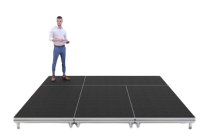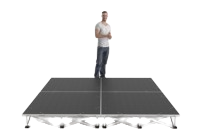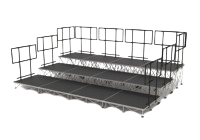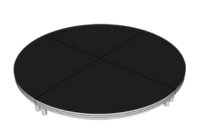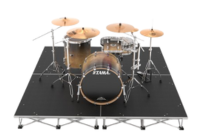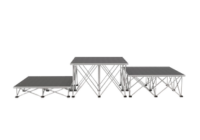Stage Systems
Reliable stage systems sit at the heart of any performance area, turning an empty floor into a professional focal point.
A stage system is essentially a collection of engineered components that interlock to create a raised, stable surface. Modern variants fall into two broad categories: fully portable stage systems intended for fast relocation, and heavier fixed units designed to stay in position long-term. Both share a common goal: to support performers, presenters, and equipment safely while keeping setup straightforward.
Core Components of a Stage Structure
- Supporting Framework – A rigid lattice or truss engineered to handle live loads without flexing.
- Deck Surface – Panels with high grip finishes, frequently birch plywood bonded to composite cores for strength.
- Connection Hardware – Quick-release clamps, locating dowels, or cam locks that align each module accurately.
- Height Adjustment – Legs or columns offered in incremental sizes, allowing several working heights from the same kit.
- Ancillary Items – Guard rails, access equipment, cable runs, and skirting for a tidy presentation.
Portable Stage Systems and Mobility
Not every venue can dedicate a permanent spot to performance space. In sports halls, conference suites, and civic centres, the stage often appears only when an event demands it. Portable stage systems address this requirement by focusing on light weight, compact storage, and uncomplicated handling.
Key traits of an effective mobile solution include:
- Sections light enough for two crew members to lift without strain.
- Slim profiles that stack on transport trolleys or nest together to conserve cupboard space.
- Tool-free latching methods speeding up assembly and dismantling.
- Durable coatings that withstand repeated movement, knocks, and occasional moisture.
Although mobility is the selling point, specification levels remain high; many portable stage systems achieve loading capacities comparable with heavier, site-built alternatives.
Appropriate Stage Structure Systems
Choosing between competing models involves more than simply matching dimensions. Consider the following:
- Intended Frequency of Use – Daily touring events demand very different hardware from once-a-term assemblies.
- Storage Footprint – Measure doorways, lifts, and available cupboards to prevent surprises.
- Weight Limits – Confirm distributed load ratings and point loads; audio line-array towers or grand pianos impose very different stresses compared with a single presenter.
- Expansion Potential – A truly modular design allows extra bays, ramps, or varying levels to be added later.
Maintenance and Lifespan
Well-crafted gear returns its investment through decades of service. Basic care recommendations are modest:
- Inspect joints, latches, and welds every time the equipment is moved.
- Wipe spillages immediately; standing liquid shortens timber life.
- Store in a dry, cool room, ideally on transport dollies to avoid warping.
- Replace damaged top surfaces promptly to preserve structural integrity.
A planned maintenance schedule coupled with occasional factory refurbishment can extend operational life far beyond the initial warranty period.
Typical Applications
The versatility of a modular stage structure sees it used well outside traditional theatre settings. Common examples include:
- Educational institutions hosting drama clubs and prize-givings.
- Hotels converting a hall into a lecture environment.
- Community halls supporting seasonal pantomimes and charity concerts.
- Civic buildings accommodating public announcements and town meetings.
- Broadcast studios requiring rapidly reconfigurable sets.
Summary
From portable stage systems used by touring presenters to permanent assemblies in municipal theatres, stage systems form the backbone of modern live production. Consistent quality, measured safety factors, and ease of handling underpin every reputable design. When selected carefully and maintained with routine checks, a robust stage structure becomes a dependable asset, supporting countless performances year after year.


